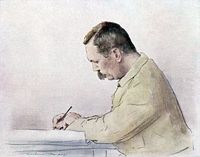Arthur Conan Doyle: Difference between revisions
imported>Tom Morris No edit summary |
imported>Tom Morris No edit summary |
||
| Line 4: | Line 4: | ||
'''Sir Arthur Ignatius Conan Doyle''' (May 22, 1859 – July 7, 1930) was a [[United Kingdom|British]] author and physician. A prolific writer, his work included [[historical novel]]s, [[Science fiction|science fiction]], [[poetry]], plays, and non-fiction. He is, however, best known as the creator of the immortal [[Sherlock Holmes]], whose fictional exploits helped popularize the new genre of [[detective fiction]]. | '''Sir Arthur Ignatius Conan Doyle''' (May 22, 1859 – July 7, 1930) was a [[United Kingdom|British]] author and physician. A prolific writer, his work included [[historical novel]]s, [[Science fiction|science fiction]], [[poetry]], plays, and non-fiction. He is, however, best known as the creator of the immortal [[Sherlock Holmes]], whose fictional exploits helped popularize the new genre of [[detective fiction]]. | ||
Despite his scientific training as a doctor (and the ruthless logic of the Sherlock Holmes character), Conan Doyle would, in his later years, publicly espouse a fascination with the supernatural, developing a belief in [[spiritualism]] and going so far as to write a book called ''The Coming of the Fairies''. He famously accepted and promoted the [[Cottingley | Despite his scientific training as a doctor (and the ruthless logic of the Sherlock Holmes character), Conan Doyle would, in his later years, publicly espouse a fascination with the supernatural, developing a belief in [[spiritualism]] and going so far as to write a book called ''The Coming of the Fairies''. He famously accepted and promoted the [[Cottingley Fairies]], where two schoolgirls, Elsie Wright and Frances Griffiths, produced photographs of [[fairies]] in their garden.<ref>James Randi Educational Foundation, [http://www.randi.org/library/cottingley/ The Case of the Cottingley Fairies].</ref> | ||
==See also== | ==See also== | ||
Revision as of 05:25, 7 July 2010
Sir Arthur Ignatius Conan Doyle (May 22, 1859 – July 7, 1930) was a British author and physician. A prolific writer, his work included historical novels, science fiction, poetry, plays, and non-fiction. He is, however, best known as the creator of the immortal Sherlock Holmes, whose fictional exploits helped popularize the new genre of detective fiction.
Despite his scientific training as a doctor (and the ruthless logic of the Sherlock Holmes character), Conan Doyle would, in his later years, publicly espouse a fascination with the supernatural, developing a belief in spiritualism and going so far as to write a book called The Coming of the Fairies. He famously accepted and promoted the Cottingley Fairies, where two schoolgirls, Elsie Wright and Frances Griffiths, produced photographs of fairies in their garden.[1]
See also
References
- ↑ James Randi Educational Foundation, The Case of the Cottingley Fairies.
